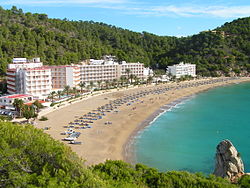Cala de Sant Vicent
| Cala de Sant Vicent | |
|---|---|
| Beach Resort Village | |

The Bay of Cala de Sant Vicent
|
|
| Location of the resort in Ibiza | |
| Coordinates: 39°4′33″N 1°35′24″E / 39.07583°N 1.59000°E | |
| Country |
|
| Region | Balearic Islands |
| Time zone | CET (UTC+1) |
| • Summer (DST) | CEST (UTC+2) |
Cala de Sant Vicent is a beach resort village on the Spanish island of Ibiza. The resort is in the municipality of Sant Joan de Labritja. The resort is reached along the designated roads PMV 811 east from Sant Joan de Labritja, and on the PM 810 north from Santa Eulària des Riu. The resort is 18.9 miles (30.4 km) north east of Ibiza Town and 23.5 miles (37.8 km) of Ibiza Airport. The resort is 3.0 kilometres (1.9 mi) along a valley, east of the small community of Sant Vicent de sa Cala.
This resort is in the isolated north-eastern tip of the island. It is a relatively quiet and child-friendly bay with a wide sandy beach. The bay is enclosed by steep cliffs to the south and the Sa Talaia which at its peak is 303 meters above sea level. The beach has clear, clean shallow waters.
In the hills above the resort there are a series of caves which encompass some of the islands oldest History. These caves can be found on the steep rocky slopes of the Cas Rierons uplands between Cala de Sant Vicent and the village of Sant Vicent de sa Cala. The small cave system was an important place and lay at the heart of Punic religious life more than two thousand years ago. The caves were first inhabited by Bronze Age settlers around 1600 BC and later was made into a shrine by Carthaginian colonist around 500 BC until 300 BC, The Carthaginian came here to worship their deities Reshef and Melkart, after which the caves became a shrine to the goddess Tanit. The caves were rediscovered in 1907 when a series of excavations took place, the last being in 1981. These dig uncovered hundreds of votive offerings which had been placed in the dark recesses of the caves to honour the gods of the ancient world. Many of the objects recovered from the caves can be seen in the Archaeological Museum in Dalt Vila (High Town) in Ibiza Town. On one side of the entrance to the cave there can be seen a cistern which has been cut into the rock. The water gathered here would have been used by the priests. Pilgrims who had made the trek here would have been ceremonially cleansed before entering the shrine.
...
Wikipedia

